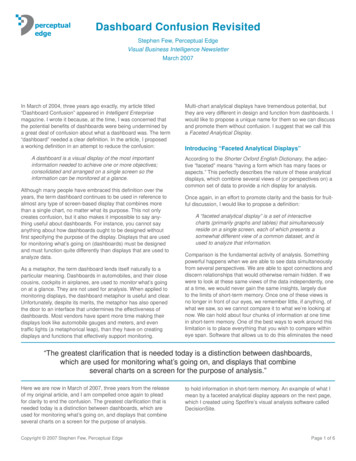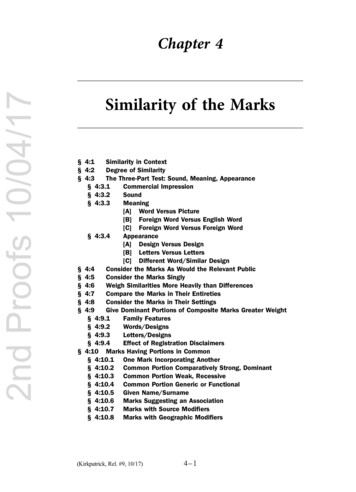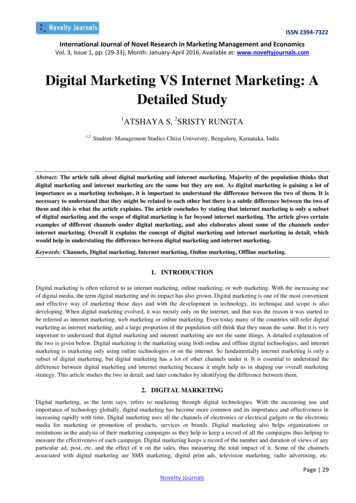
Transcription
Bachelor Thesis, 15 credits, for a Bachelor of Science in BusinessAdministration: International Business and MarketingSpring 2017The Confusion of Content MarketingA study to clarify the key dimensions of content marketingAmanda Claesson and Albin JonssonSchool of health and society
Claesson & JonssonAuthorAmanda Claesson and Albin JonssonTitleThe confusion of Content Marketing, A study to clarify the key dimensions of content marketingSupervisorLisa KällströmCo-examinerMarina JogmarkExaminerSven-Olof CollinAbstractContent marketing is a popular marketing strategy, which has increased significantly during the lastyears. The term content marketing is new but companies have been working with parts of the strategyfor decades. The new digital era changed the communication from a one-way to a two-way communication. Customers now have a demand for relevant content that is valuable for them.The purpose of this dissertation is to develop an understanding of this marketing strategy, and clarifythe key dimensions that distinguish content marketing from other marketing strategies. This thesis restson a realistic philosophy with an abductive approach.Based on previous research different definitions of the marketing strategy are used to develop a modelof the key dimensions of content marketing. A qualitative data collection with semi-structured interviewsis performed on seven participants in order to explore what is seen as important aspects, and to gathernew insight about the unclear marketing strategy.The findings indicate a differentiation between companies, but there is a consensus of the most important aspects. Findings of how the strategy is done results in a new model, and a new definition of themarketing strategy. Suggestions for further research include examining how companies measure content marketing.The results contribute with a clarification and further description of what content marketing is, and themost important aspects to consider when working with the strategy. The results of this study are usefulas a guideline for people starting to work with content marketing, with the aim to understand the marketing strategy.KeywordsContent marketing, marketing strategies, digital marketing, online marketing, branded content
AcknowledgementsThis bachelor thesis concludes our three years of studies at Kristianstad University.First, we would like to thank our supervisor, Lisa Källström, for her exceptionalknowledge, and encouragement in our confusion around this difficult and complexsubject. Without her help we would not have managed to write this dissertation. Also,we would like to thank Annika Fjelkner for her engagement, and supervision of linguistics and format.We would like to give our thankfulness to all of the participants in our study for answering our questions during the interviews. Without them this study would not havebeen possible.Finally, we would like to thank each other for great teamwork, and support during thisdifficult but fun, and educative time of studies.Kristianstad, 2017-05-26Amanda ClaessonAlbin Jonsson
Claesson & JonssonTable of Contents1. Introduction . 61.1 Background. 61.2 Problematization . 81.3 Research question . 101.4 Purpose . 101.5 Limitations . 101.6 Outline . 112. Research method . 122.1 Introduction . 122.2 Research philosophy . 132.3 Research approach . 132.4 Choice of theory . 142.5 Choice of methodology . 142.6 Critique of the sources . 152.7 Summary . 153. Literature review . 163.1 The history of content marketing . 163.2 Definitions of content marketing . 183.3 Digital marketing and content marketing . 203.4 Dimensions of content marketing . 213.4.1 Strategy . 223.4.1.1 Target a specific audience . 223.4.1.2 Reflect company values and brand image . 233.4.1.3 Customer needs . 233.4.2 Activity. 243.4.2.1 Two-way communication . 243.4.2.2 Delivering consistent content . 253.4.2.3 Storytelling . 273.4.2.4 Informative content without the perspective of sales . 273.4.2.5 Entertaining your audience . 283.4.3 Results . 283.4.3.1 Value . 283.4.3.2 Trust . 283.4.3.3 Profitable customer action . 293.4.4 Model of the key dimensions of content marketing. 294. Empirical method . 314.1 Research design and strategy . 314.2 Time horizon . 324.3 Data collection . 324.4 Selection of participants . 334.5 Interviews . 344.5.1 Semi-structured interviews. 344.5.2 Interview guide . 354.5.3 Transcriptions . 364.5.4 Data analysis . 364.6 Trustworthiness . 374.7 Ethical considerations . 385. Empirical findings and analysis . 395.1 Key dimensions of content marketing . 395.1.1 Strategy . 394
Claesson & Jonsson5.1.1.1 Target a specific audience . 415.1.1.2 Reflect company values and brand image . 415.1.1.3 Customer needs . 425.1.2 Activity. 435.1.2.1 Two-way communication . 445.1.2.2 Delivering consistent content . 455.1.2.3 Storytelling . 465.1.2.4 Informative content without the perspective of sales . 465.1.2.5 Entertaining your audience . 465.1.2.6 Editorial perspective. 475.1.2.7 Digital content . 475.1.3 Results . 485.1.3.1 Value . 495.1.3.2 Trust . 495.1.3.3 Profitable customer action . 505.1.3.4 Relationship building . 505.1.4 Review of the model of the key dimensions . 505.3 The concept content marketing . 525.3.1 Definitions of content marketing . 535.3.2 Comparison between content marketing and marketing . 555.4 Conclusion of the analysis . 566. Thesis conclusions . 596.1 Summary of this dissertation . 596.2 Conclusion . 596.3 Practical implications . 616.4 Suggestions for further research . 61References . 63Appendix 1- Interview guide 1 . 67Appendix 2- Information inför intervju . 70Appendix 3- Interview guide 2 . 715
Claesson & Jonsson1. IntroductionIn this chapter the background, and problematization of content marketing is described. The chapter continues with the research question, purpose, and limitations ofthis dissertation. At the end of this chapter, the outline of the following chapters ispresented.1.1 BackgroundThe concept “content marketing” has over 25 million search results on Google andaccording to Google Trends, the search item has increased significantly during the lastyears. A new digital era started in 2005, known as Web 2.0, which actively encouraged participation between companies and potential customers (Cosh, Burns, &Daniel, 2008). This opened up for a two-way communication between companies andcustomers, where customers can interact and comment on the published content(Cosh, Burns, & Daniel, 2008). Marketing strategies changed from a one-way to atwo-way communication, and this was the emergence of digital marketing and the riseof content marketing (Patrutiu Baltes, 2015).According to Joe Pulizzi (2012) who is the founder of the leading global content marketing education and training organization, Content Market Institute (CMI, 2017),content marketing is not a new concept. It has been around for over hundred years andstarted late 1800s with John Deere’s magazine The Furrow. John Deere’s magazineThe Furrow is one of the first examples of content marketing, and is a source of information to its target audience (Pulizzi, 2012).Marketing, that used to be only push marketing, have changed from a sales perspective to a combination between push marketing, and pull marketing. This change hasled to more interaction with customers and requires innovative content (Eldeman,2010; Kotler, Keller, Brady, Goodman, & Hansen, 2009). Traditional marketing strategies deliver their advertisements through paid media, which are both standardizedand personalized (Malthouse, 2007). The definition of marketing, according to American Marketing Association (AMA), which is the essential community for marketers(AMA, 2013, p. 1), is the following:6
Claesson & JonssonMarketing is the activity, set of institutions, and processes for creating, communicating, delivering, and exchanging offerings that have value for customers, clients, partners, and society at large.The definition of marketing is a general definition of all marketing strategies. Contentmarketing can be seen as a sub-branch within marketing. However, there is no common accepted definition or description for content marketing, which is very confusing(Holliman & Rowley, 2014). One out of the many definitions is CMI’s (2017) definition of content marketing, which is a wide description of content marketing, and issimilar to the definition of marketing (CMI, 2017, p.1):Content marketing is a strategic marketing approach focused on creating anddistributing valuable, relevant, and consistent content to attract and retain aclearly-defined audience – and, ultimately, to drive profitable customer action.With this stated, according to CMI (2017) content marketing is the process of creatingpersonalized valuable content to an interactive, engaged, and targeted audience (CMI,2017). Both definitions, marketing and content marketing, state that it is a process ofcreating and delivering any offerings or content that contributes value for customers.Marketing has to contribute value for customers, stakeholders, and society at large,compared to content marketing that only focus on delivering value to a clearly definedand targeted audience. Both marketing and content marketing has the perspective ofprofitable customer action. It is underlined in the definition of content marketing, dueto the focus to inform potential customers, and do not have the focus on sales (CMI,2017). Therefore, the profitable perspective of content marketing can easily be forgotten. According to Pulizzi (2013), the content has to provide information with thecompanies’ business goals in order to be referred as content marketing. The definitionof marketing and the definition of content marketing do not differentiate much fromeach other. However, three elements from the definition of content marketing differentiate when comparing CMI’s (2017) definition of content marketing with AMA’s(2013) definition of marketing: (1) valuable and consistent content, (2) acquire andengage, (3) specific clearly targeted audience.According to Rowley (2008), content marketing interacts more with the audience thanother marketing strategies by mostly using a two-way communication. When usingcontent marketing, digital communities and channels are efficient and help customersto interact and engage with the delivered content (Lieb, 2011). The content has to at7
Claesson & Jonssontract and retain customers by consistently creating and present content in order to intensify or change consumer behavior (Pulizzi, 2013). The content has to be ownedand controlled by the organization, which means that the content has to be publishedon companies’ own media channels, for example their webpage (Pulizzi, 2013; Wang,Qiao, & Peng, 2015).1.2 ProblematizationThe shift from a one-way to a two-way interaction is important for companies whendelivering relevant content to the right audience. Therefore, the importance of contentmarketing has increased (Pulizzi & Barrett, 2009). Companies should consider to usecontent marketing since potential customers are searching for relevant content thatengage, entertain, and educate them (Halligan & Shah, 2010; Odden, 2012; Holliman& Rowley, 2014). Customers want to enter a relationship with a company before theypurchase their product or service (Odden, 2012). To meet customers’ requirements,companies need to change from a selling perspective to a more informative and helpful perspective (Jefferson & Tanton, 2013).However, according to Holliman and Rowley (2014), a lot of companies do not investas much resources as needed in content marketing. This is because there is confusionin the understanding about what content marketing consists of, and why it should beof importance to implement this marketing strategy. It is also challenging to implement the strategy because the large amount of dimensions, which is important in thecreation of content marketing (Holliman & Rowley, 2014). Content marketing is perceived and interpreted differently, which results in various definitions with many dimensions of the marketing strategy. Even if companies work with some dimensions ofcontent marketing, it causes difficulties and confusion to say that they are workingwith the marketing strategy. This is because they have different perceptions of whatcontent marketing is, and some companies may work with what is seen as the conceptcontent marketing, but to them content marketing contains other aspects (Du Plessis,2015; Pulizzi, 2013; Järvinen & Taiminen, 2016).Previous research has contributed with a variety of theoretical definitions and explanations where they highlight several aspects that are seen as important for contentmarketing. However, the wide range of explanations contradicts each other, and is8
Claesson & Jonssonemphasizing different aspects. This has led to confusion of the marketing strategy(Holliman & Rowley, 2014). According to Du Plessis (2015), there is an abundanceof different aspects of what content marketing consists of. The practitioners’ perspectives dominate content marketing through several marketing organizations, whereContent Marketing Institute (CMI) and Content Marketing Association (CMA) aretwo out of many. In CMI’s latest research about the usage of content marketing inNorth America, nine out of ten answered that they work with content marketing(Holliman & Rowley, 2014). Even if companies say that they are working with content marketing, there is a gap in the understanding of the specific aspects, and howcontent marketing differentiates from other marketing strategies (Du Plessis, 2015). Itis difficult to say if a company actually works with content marketing, or if they onlyuse the term content marketing for the same marketing strategy that they always haveperformed (Du Plessis, 2015).The definition of marketing and the definition of content marketing, do not vary significantly (Holliman & Rowley, 2014). Therefore, it is unclear what content marketing actually is, and what specific dimension that distinguish content marketing frommarketing. This thesis will emphasize how companies work with content marketing,what companies see as key dimensions, and important aspects to consider when usingcontent marketing. As mentioned in the background, content marketing consists ofseveral aspects that are repeated in numerous of articles, and in combination formcontent marketing. According to Pulizzi and Handley (2016), the marketing strategy,content marketing, is popular and commonly used. However, companies that claim towork with content marketing may not actually work with what is seen as the aspectsof this marketing strategy, due to the confusion about content marketing, and variousperceptions of what the marketing strategy is (Järvinen & Taiminen, 2016).Content marketing is still under researched in the academic field and the existing research provides a wide range of definitions, and aspects of what content marketing are(Holliman & Rowley, 2014). Therefore, it is important to investigate this marketingstrategy, and get an understanding for what is seen as the key dimensions of contentmarketing. This dissertation will contribute with knowledge, and clarifications aboutwhat content marketing really is. There is criticism that this marketing strategy is nota new concept, and that the dimensions are the same as in other marketing strategies9
Claesson & Jonsson(Du Plessis, 2015; Holliman & Rowley, 2014; Lieb, 2011). The criticism is based onthe fact that companies always has worked with the many dimensions, but not referred it as content marketing. Therefore, we want to investigate what specific aspectsthat distinguish content marketing from other marketing strategies.1.3 Research questionHow do companies work with content marketing, and what is seen as the key dimensions of this marketing strategy?1.4 PurposeThe aim of this study is to develop an understanding of the marketing strategy contentmarketing, and clarify the key dimensions that distinguish content marketing fromother marketing strategies. With the hope to contribute to the academic research withclarifications to the unclear concept content marketing, the purpose is to strengthenprevious research and contribute with new perspectives and findings to increase theunderstanding of content marketing. Therefore, this dissertation’s objective is to examine how companies work with content marketing, and what the specific dimensionsthat is of importance for their content marketing strategy.1.5 LimitationsOne limitation of this research is that only companies who state they are working withcontent marketing are being examined. Therefore, the answers from the interviewswill be from people with expertise, and experience within content marketing. Anotherlimitation is that only companies that have been working with two specific selectedmarketing agencies are examined in this research. This is due to the time limit of thisstudy, and therefore, generalizations cannot be made.10
Claesson & Jonsson1.6 OutlineChapter 1- IntroductionThis dissertation consists of six chapters. The first chapter is an introductionand contains a background, and the problematization behind content marketing.The chapter continues with the research question, the purpose of this thesis, andthe limitations. The chapter ends with the outline of the rest of the thesis.Chapter 2- Research methodThe second chapter is about the research methods used in this study of contentmarketing. The chapter includes research philosophy, approach and design, thechoice of theory, and choice of methodology. Lastly, chapter two end withcritique of sources and, brief summary about the method used in this thesis.Chapter 3- Literature reviewThe third chapter is the literature review and starts with a section of thehistory behind content marketing. This section follows with the definitions ofcontent marketing, and digital marketing. Lastly, the different dimensions ofcontent marketing are presented according to different categories anddimensions.Chapter 4- Empirical methodChapter four contains the empirical method that consists of the research designand strategy. The chapter follows with time horizon, data collection, samplesection, the interviews, and trustworthiness. The empirical method ends with adiscussion about ethical considerations.Chapter 5- AnalysisChapter five is where the empirical findings and analysis is presented. Thischapter starts with the empirical findings and analysis of the model of the keydimensions. The chapter continues with the concept content marketing, and acomparison of the definitions of this marketing strategy. The chapter ends in aconclusion of the analysis.Chapter 6- Thesis conclusionThe last chapter in this dissertation, chapter six, is the conclusion of ourresearch. This chapter consists of a summary of this dissertation, a conclusion,and practical implications. Chapter six ends with suggestions for furtherresearch.11
Claesson & Jonsson2. Research methodIn this chapter the choice of methodologies are presented. The purpose with thischapter is to present the methods used in this dissertation. It contains research philosophy, research approach, choice of theory, and choice of methodology. Chaptertwo ends with critique of sources and a brief summary.2.1 IntroductionThe research onion by Saunders, Lewis, and Thornhill (2009) are used to better understand how the different stages of research methodology are dependent on each other. In this dissertation a similar structure is used, but this model consists of seven different layers, placed in the following order: research philosophy, research approach,research choices, research designs, research strategies, research time horizons, andlastly techniques and procedures. Each layer consists of different research approaches,and the most suitable one are chosen in this dissertation. The research onion startsfrom the outside layer, which is research philosophy and continues towards the centerof the onion, which consists of data collection and data analysis (Saunders et al.,2009). In this chapter the first three layers will be explained, and the last four layerswill be explained further in chapter lanatoryAction researchCase studySurveyExperimentDesignsGrounded sectionalStrategiesTime horizonsDatacollectionTechniques and proceduresFigure 2.1 The research onion(Based on Saunders et al. (2009) Research methods for business students p.108)12
Claesson & Jonsson2.2 Research philosophyThe research philosophy allows the writers to relate, and make assumptions to the researchers’ defined ideas about how they view the world. These assumptions will affect the research methods and strategies that this dissertation will use. The differentphilosophies according to Figure 2.1- The Research onion is: positivism, realism, intepretivism, and pragmatism (Saunders et al., 2009). Positivism is a philosophy thatallows the researcher to view the social reality with observations, and the final resultof this research method is law-like generalizations. Another philosophical view is realism, which relates to how people sense and observe the world, and if the realityshows the truth. The realistic approach has similar characteristics as the positivisticphilosophy. They both assume a scientific method to develop knowledge. H
The confusion of Content Marketing, A study to clarify the key dimensions of content marketing Supervisor Lisa Källström Co-examiner Marina Jogmark Examiner Sven-Olof Collin Abstract Content marketing is a popular marketing strategy, which has increased significantly during the last years.










